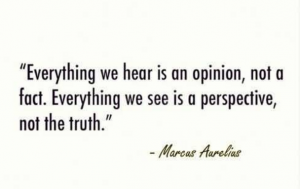Have you ever wondered how two people can see, hear or experience the same event or conversation and walk away with a completely different perspective?
This week I have reflected on this thought:
If an event happens—two people are involved and have two different versions of what happened—where does the truth lie within? How do we find it? How do we see it? Most of all—how do we accept and understand that it is blended between the two perspectives?
Our views are shaped by our experiences, preferences, values and relationships. We do not realize how these factors affect our view but they do because they often veil the outcome in some way.
It is important that we as adults step back and think through events to truly see where the truth or facts lie. It is tough because we know how we feel and what we BELIEVE should have happened and therefore the events are often exaggerated when they do not meet our value system or down played if they do.
My example, yelling. I am not a person who speaks loudly (most of the time) and it causes me anxiety when I am immersed in a situation with noise and what I consider loud voices. When I am in a situation, it is very important for me to remember that a loud voice does not necessarily mean anger or frustration and that should not provide a negative connotation to the event.
Since, this is difficult because we have strong belief systems, we must really think about activities that can help our students develop the understanding that each person sees situations differently. We must remember that as adults when we interact with others we are teaching it to our students.
Here are 3 simple ideas to begin discussions of perspective.
- Perspective from a Window
Have students look out a window for 2 minutes. Give them time to write one sentence. Share sentences.
Discuss:
- What was focused on?
- What was important to write about?
- Were statements general or specific about one thing? Why?
- Folding Paper Activity
Have students follow these directions:
- Fold the paper in half
- Fold the paper in half again.
- Tear off the bottom right hand corner.
- Turn the paper upside down.
- Tear off the bottom right corner.
Discuss:
- How did you feel when you showed your paper?
- Did you feel you did yours correctly? Someone else was wrong?
- Why were there so many different versions?
- Was there one answer or correct way?
*Tell students to imagine that the paper is their perspective or the way they see things. What can we learn about perspective from this activity? How can we learn from others about seeing things differently?
- Perspecs: http://www.perspecsnews.com/
This is a great website with news articles that are presented in two perspectives and one factual article. Not all the articles are appropriate so you must preview what you are assigning but it is definitely worth checking out.
The world we live in is full of ideas, values, experiences and opinions—my hope is that we expose our students to many ideas and MOST of all the ability to step back and think about why someone else might see or think something different. It is important for us to emphasize that listening and considering someone’s idea does not mean you agree with it but you understand that someone else feels or sees something different.
Resources used to create this Blog:
Perspecs